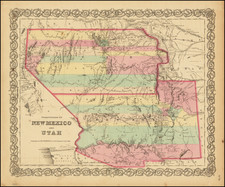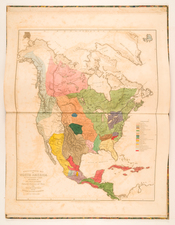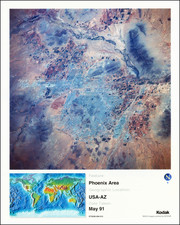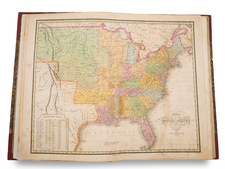Yuma in 1933: a Detailed Snapshot of the Built Environment
Yuma, Yuma Co. Ariz., a fire insurance atlas produced by the Sanborn Map Company in April 1927 and updated to December 1933, provides an exhaustive survey of Yuma's urban infrastructure, complete with extensive details on water facilities, the local fire department, and business establishments. This 24-sheet atlas offers not just a representation of the area's urban landscape, but a snapshot of a community's diverse business environment during the early 20th century.
In the 1920s, Yuma, experienced significant growth and transformation. The present atlas, with extensive pasted updates, attests to the changes underway in Yuma between 1927 and 1933. Located at the confluence of the Colorado River and the Gila River, Yuma's strategic position made it an important transit point during the westward expansion of the United States. The construction of the Ocean-to-Ocean Highway Bridge in 1915 had already boosted its connectivity, and by the 1920s, Yuma became a pivotal stopover for those traveling between the East and West Coasts. The decade also witnessed the introduction of modern amenities and infrastructural improvements. Furthermore, the completion of the Imperial Dam and All-American Canal system in the late 1920s brought extensive irrigation to the desert region, laying the foundation for Yuma's future as a significant agricultural hub, especially for winter vegetables.
The atlas's content doesn't just limit itself to fire response; it methodically covers Yuma's built environment, including both commercial and residential buildings. Symbolic notations, from shingle roofing types to fire-resistant designs, provide insight onto construction trends and safety standards of the era. Furthermore, the color-coded representation of building materials—yellow for frame, red for brick, blue for stone, among others—serves as a testament to the diverse architectural landscape that characterized Yuma at the time. A particularly unique facet of Sanborn atlases is the detailed portrayal of the internal layouts of significant industrial establishments.
A selection of the businesses and other sites on the maps here follows:
- Arizona - Edison Co. Water Plant
- Old Yuma Penitentiary Inn to be built over Cell House
- Mexican Shacks (various locations).
- Southwestern Ice & Cold Storage Co.
- Yuma Union High School
- Hotel del Ming (built in 1926. Still standing. On National Register of Historic Places)
- Alpha Steam Laundry
- E. F. Sanguinetti's General Merchandise
- Yuma Municipal Swimming Pool / Dance Pavilion
- Yuma Farmers Cooperative Assn.
- Yuma General Hospital
- Cheap Indian & Mexican Shacks (between Madison and Cemetery Avenues)
- Southern Pacific Co.'s Yard & Shops (Numerous Cheap Mexican Shacks Here)
- Auto Camp
- Cabarets (various)
- Undertaker (Hearse auto & coffin storage)
Rarity
Very rare in the market. Our 1927 edition may be the unique surviving exemplar with the extensive 1933 pasted updates. OCLC locates only a single example of a 24-sheet Yuma, Arizona Sanborn Atlas (dated "1916?"), in the New York Public Library. California State Northridge lists a holding for the 1927 base edition. The Library of Congress has Yuma Sanborn Atlases for 1893, 1896, 1901, 1911, 1917, and 1927 (but not the present iteration updated to 1933).
The Sanborn Map Company, founded in the 1860s by Daniel Alfred Sanborn, is a renowned cartographic institution primarily recognized for its unparalleled fire insurance atlases. These atlases emerged as indispensable tools during the late 19th and early 20th centuries, portraying the evolution of urban America with unprecedented detail and precision. Charting both burgeoning metropolises and smaller municipalities, Sanborn's fire insurance maps provide a unique and illuminating perspective on the physical, economic, and social transformation of the nation during a period of intense urbanization and industrialization.
During the latter half of the 19th century, the United States witnessed an acceleration in urban growth. This shift from rural to urban living, bolstered by the advent of the Industrial Revolution, generated densely populated areas with a diverse array of architectural styles, materials, and infrastructure. In this context, the need for comprehensive maps that could illustrate the specifics of the built urban fabric became paramount, especially for insurance companies seeking to assess the risks associated with insuring individual properties. The Sanborn Map Company responded to this demand, creating elaborate maps that identified building materials, the purpose of structures, and even features like fire walls and sprinkler systems.
A standout feature of Sanborn's maps was their color-coding system, which allowed for a swift and clear differentiation between building materials—whether wood, brick, iron, or otherwise. This system, paired with the company's legends -- detailing everything from the width of streets to the locations of hydrants -- made these atlases an invaluable resource for insurance underwriters. By the turn of the 20th century, Sanborn maps covered thousands of cities and towns across the United States.
Beyond their utility to the insurance industry, the atlases produced by the Sanborn Map Company have, over time, become a treasured resource for historians, urban planners, preservationists, and environmental researchers. These maps have also been pivotal in brownfield research, shedding light on past industrial activities and potential contamination sites. They offer a window into the past, capturing the architectural, infrastructural, and environmental trends of various eras, and revealing the intricacies of a city's development. The very design of streets, the evolution of residential and commercial areas, and the rise and decline of certain industries can be traced through these maps.
Around 1960, Warren Buffett, then a burgeoning value investor, took a significant position in Sanborn Map Co., sinking 35% of his partnership's money into the company. Buffett was drawn to Sanborn's extensive map business, which he described as a virtual monopoly, as well as the company's valuable investment portfolio. While the cartographic aspect of Sanborn's business was diminishing in profitability due to technological advances introduced by competitors, Buffett recognized that the informational content of the maps had not been updated to electronic access, and was thus an undervalued asset for the company. His investment in Sanborn Map Co. is often presented as Case Study No. 1 in overviews of his value-oriented investment philosophy, which emphasized undervalued assets.
In sum, the Sanborn Map Company's fire insurance atlases are not merely maps; they are intricate tapestries of American urban history, detailing the nation's progression from the late 19th to the 20th century. Through their detailed renderings, these maps continue to serve as invaluable chronicles of the United States' urban transformation during a pivotal era.











![[Composite Atlas of the World]](https://storage.googleapis.com/raremaps/img/small/103160.jpg)



![[ Early Western Automobile Road Map ] Goodrich Road Map of Arizona - Colorado - New Mexico - Utah](https://storage.googleapis.com/raremaps/img/small/101927.jpg)
